|
ARBOR ASLAN-W722C
Capacitive multi-touch wide-screen 21.5-inch industrial Panel PC for intelligent factory and other fixed-mount applications
By Conrad H. Blickenstorfer; photography by Carol Cotton
Panel PCs are the unsung heroes of rugged computing. They aren't status symbols sitting on desks and in board rooms, they aren't sleek high-tech devices like the latest smartphones and tablets, and they aren't used in high-profile applications like rugged notebooks and convertibles. Instead, they're mounted in cabinets and walls and nondescript enclosures in factories and such, where they are counted on to reliably run and do their job. Without breaking down or holding things up. Panel PCs are generally also big and bulk, and we less often get them for examination in our RuggedPCReview lab. So it was a nice change of pace when ARBOR Technology, via their ARBOR Solution Inc operation in San Jose, California, sent us one of their new ASLAN widescreen Panel PCs for review.

Who is ARBOR? They are one of the numerous smaller Taiwan-based tech companies that never stop to find ways to leverage their core expertise into new and promising areas of technology. Founded in 1993, ARBOR began in embedded computing and networking, quickly expanded into industrial computing platforms and solutions, and from there also into rugged handhelds and tablets (like the Gladius 5 and Gladius 8 we recently reviewed).
With its ASLAN series of rugged Panel PCs, ARBOR combined its embedded systems background with the rugged systems expertise the company gained with the Gladius mobile devices. And, always attuned to new and emerging trends, ARBOR didn't just design their new panels for everyday yeoman duty in industry and commerce; they also envisioned how new and evolved panels might fit into the emerging paradigm of "Industry 4.0."
ASLAN and Industry 4.0
In its introductory and marketing materials for the ASLAN series, ARBOR pointed out that today's industrial organizations are facing the challenge of managing rapidly increasing data loads, integrating machine-to-machine devices, and seamlessly sharing data in real-time to align to emerging Internet of Things and Industry 4.0 applications.
By now most know that "Internet of Things" refers to an emerging future where Internet connectivity increasingly includes all sorts of sensor-equipped devices instead of just computers, but what is Industry 4.0, and what does the ASLAN panel bring to the Industry 4.0 table?
In essence, using the Industry 4.0 nomenclature, Industry 1.0 was the emergence of mechanical production in the first place (water, steam, etc.), Industry 2.0 refers to the introduction of mass production (electricity, assembly lines), Industry 3.0 to emerging industrial automation (PCs, robots and such), and now industry 4.0 where intelligent networked systems go beyond mere machine control via feedback systems, interdisciplinary cooperation, IoT technology, and advanced resource/demand management to morph into "intelligent" or at least "smart" factories.
Much of this, of course, is software, sensor technology and expanded networking, but a lot also relies on evolved computer hardware that can do more than just basic human-machine interface tasks. To that extent, when ARBOR created the ASLAN panel, they paid extra attention to tasks such as connecting facilities, collecting data streams from various sources, and controlling production processes in accordance with both current and evolving Industry 4.0 application requirements.
The image below shows the frontal view and all four sides of the ARBOR ASLAN W722C:
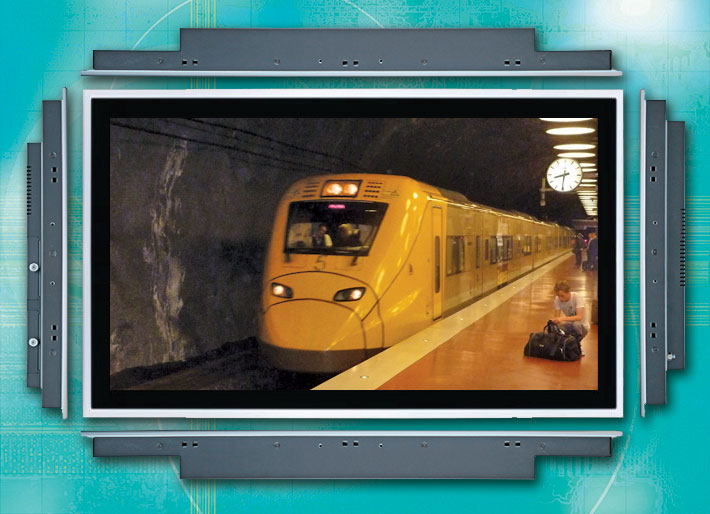
As far as the display and general size goes, the ASLAN W722C is the largest of three ASLAN models, the other two having 15.6 and 18.5-inch screens. The W722C screen measures 21.5 inches diagonally, the same as the smaller of the two available Apple iMacs, with which the ASLAN shares full 1080p 1920 x 1080 pixel resolution. That makes for a fashionably wide 16:9 aspect ratio, the one used in virtually all current HDTVs.
In an era where late model smartphones also offer full 1080p resolution and often more, that's no longer exceptional, but the ASLAN display makes the best of it, being crisper and sharper than other 1080p desktop displays in our office, and also offering perfect viewing angles from all direction, without any color shifts or optical aberrations at all. And while a big panel computer cannot possibly be a lighweight, the very sturdy ASLAN weighs less than three pounds more than the consumer iMac (15.4 vs. 12.5 pounds).
The overall design of the ASLAN panel is clean and simple, with no controls or indicator lights on the front at all. The left side provides access to the unit's two storage media bays. The other three sides are unadorned.
All I/O is on the back of the ASLAN. The image below is a close-up of the I/O block that provides four full-size USB ports, three of the 2.0 variety and one of the newer and faster 3.0 standard. There are three RJ45 jacks, four standard DB9 serial ports, two of which are straight RS232 and two RS232/485 with auto flow control, and a DVI-I connector. There's also a three prong power connector for 9 to 36 Volt DC, and a simple on-off switch.
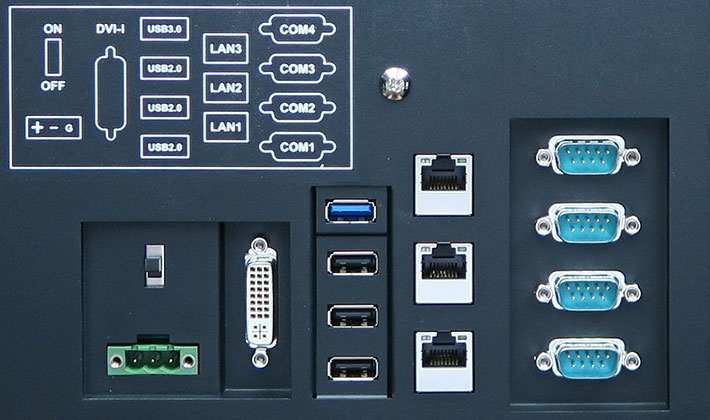
While the optimal design and configuration of Industry 4.0 hardware componentry may not have fully emerged just yet, ARBOR is likely on the right track by equipping ASLAN panels with three independent RJ45 LAN interfaces to simultaneously allow remote terminal connections, M2M communication, as well as supporting company intranet and cloud connectivity. Using modern capacitive multi-touch helps on the human side of things, and still providing a quartet of legacy COM ports makes sense as well, as not all tech advances at the same pace.
Under the hood
Creating a panel computer brings up entirely different design contemplations from deciding on how to best build a laptop, handheld or tablet. Panel PCs generally have large displays, so there's enough of a footprint behind the panel and miniaturization isn't an issue. Since panels are fixed-mounts, weight is much less of a consideration compared to building a mobile device. And since there's usually ample space behind panels, thickness and good industrial design also aren't major issues.
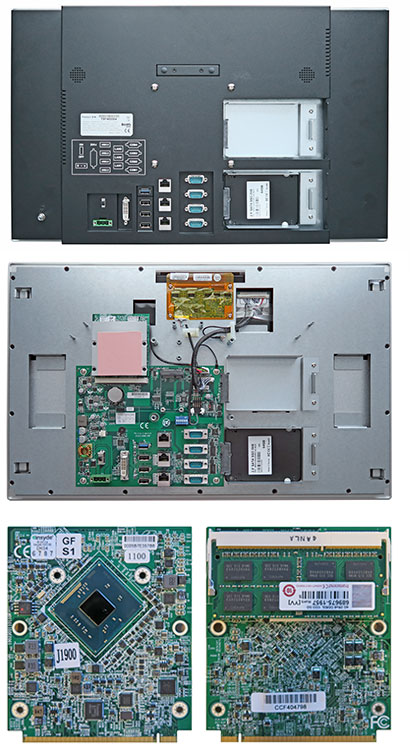 Or are they? If so, then someone forgot to tell ARBOR, because the ASLAN-W722C is remarkably thin, less than two inches. And it's also beautifully finished not only in the front where everyone can see, but also in the back that no one ever sees, except perhaps every once in a while an installer or service technician. Or are they? If so, then someone forgot to tell ARBOR, because the ASLAN-W722C is remarkably thin, less than two inches. And it's also beautifully finished not only in the front where everyone can see, but also in the back that no one ever sees, except perhaps every once in a while an installer or service technician.
So the first impression one gets upon examining the big ASLAN is that for a 21.5-inch industrial panel, the W722C is indeed remarkably thin, and also remarkably solid. That's primarily because this machine is almost all metal.
The front bezel is really more than a bezel. It's a hefty aluminum piece with flush protective glass set into its front. The front bezel is then attached to the steel chassis via 18 Philips head screws.
The back half, painted black on the outside, then fits over the steel chassis and into a groove of the aluminum front bezel. I expected a seal in side this classic tongue-and-groove design but there wasn't one.
That's probably because while the front panel provides IP65 ingress protection, the backside of the panel is not sealed and doesn't carry a protection rating. That is common in most panel PCs that usually have a seal between the device and the panel they are fitted into.
The steel chassis is industrial strength, and not the super-thin and often rather flimsy metal found in consumer devices.
The actual electronics of the ASLAN take far less room than is available in a large panel. The system board itself is a rectangular 195 x 160 mm affair that's not actually the motherboard.
That's because in true embedded systems style, there's a roughly 85 x 74 mm "Process Control Card" that has the system processor on one side and a single SO-DIMM slot on the other (populated by a 4GBDDR3L 1333 RAM module by Transcend). Having the SO-DIMM slot in that position means the backside of the panel has to be removed, as well as the CPU board, in order to get to the RAM slot.
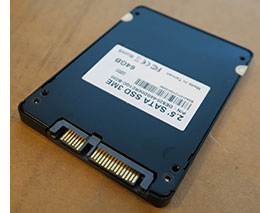 The two disk bays come standard with a simple and very sturdy metal storage device caddy into which the actual storage device is then mounted. The caddy is tall enough even for thicker 2.5-inch devices. Our sample unit came with an innodisk Industrial 2.5" SATA 3ME Series SSD (see innodisk product page) The two disk bays come standard with a simple and very sturdy metal storage device caddy into which the actual storage device is then mounted. The caddy is tall enough even for thicker 2.5-inch devices. Our sample unit came with an innodisk Industrial 2.5" SATA 3ME Series SSD (see innodisk product page)
Cooling to the CPU is provided by a beautifully machined 70 x 70mm heat spreader that connects both to the CPU on the bottom and to the backside metal cover on top via pads of heat-conducting material.
The system board is somewhat unusual in that all of its external I/O connectors are mounted on its surface, rather than along the edge(s) as is usually the case in most PCs, both desktops and laptops.
There is a full-size mini-PCIe slot for the optional Atheros WiFi module (or whatever else is desired instead), two standard SATA edge-mounted connectors that can accommodate either 2.5-inch hard disks, 2.5" SSDs or, via optional adapter, CFast cards.
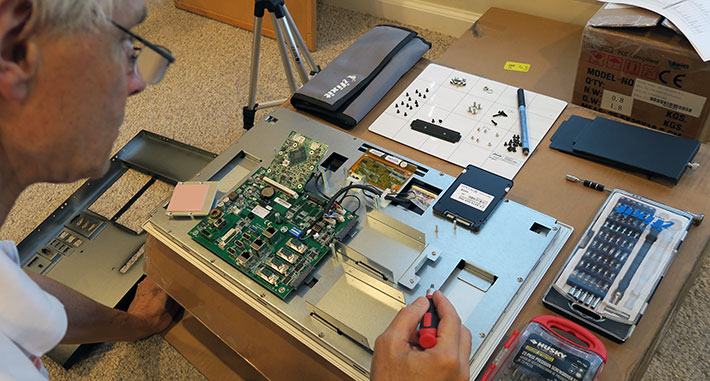
How much performance does a panel need?
Now what about performance? What sort of a processor should a Panel PC like the ASLAN Series have? That's a tough call to make. While most consumer PCs need as much punch as possible just to keep up with their full-size, full-service operating systems, massive applications, even larger games, and the ever-increasing multi-media and streaming video loads, most industrial panels run comparatively simple dedicated custom applications that rarely, if ever, change, and whose resource requirements are well known. Which means it doesn't make sense to give a panel more performance (read cost and cooling) than it actually needs. BUT the panel still must get the job done, reliably and without working up a sweat.
To meet that tricky challenge, ARBOR selected the Intel Celeron J1900 processor, which is part of Intel's large "Bay Trail" family of CPUs that includes Atom, Celeron and even Pentium branded chips. But hasn't Intel traditionally used the Celeron brand largely for its barest entry level processors? 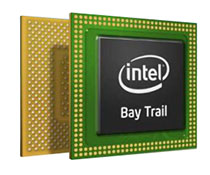 That's no longer the case. While all "Bay Trail" chips are based on a heavily overhauled Intel Atom architecture, they now include graphics that use the same Intel execution units (EUs) as Ivy Bridge's HD 4000. This gives them support for most of the same APIs and features as the much more expensive Core processors. There's USB 3.0, 22nm lithography, and the 64-bit instruction set. And DirectX 11, OpenGL 3.X, and OpenCL 1.2 are all present on the API side. That's no longer the case. While all "Bay Trail" chips are based on a heavily overhauled Intel Atom architecture, they now include graphics that use the same Intel execution units (EUs) as Ivy Bridge's HD 4000. This gives them support for most of the same APIs and features as the much more expensive Core processors. There's USB 3.0, 22nm lithography, and the 64-bit instruction set. And DirectX 11, OpenGL 3.X, and OpenCL 1.2 are all present on the API side.
So the quad-core Celeron J1900 processor powering ARBOR's ASLAN Industrial Panel PC packs far more of a punch than earlier chips in fanless packages, even though its thermal design power is just 10 watts, less than that of even ultra-low voltage mobile Intel Core processors.
What all this means is that as far as performance goes, customers will have to figure out if the Celeron J1900 and its supporting cast fits the bill for the task at hand, as ARBOR currently doesn't offer processor options. Such options ought to be possible given the "Process Control Card" design approach which is a natural for offering scalable performance.
As is, to see what kind of performance this ARBOR panel computer can generate, we ran our standard benchmark suite, Passmark Software's PerformanceTest 6.1, that runs about 30 tests covering CPU, 2D graphics, 3D graphics, memory, and disk and then computes scores for each category and an overall PassMark score. We also ran our second benchmark suite, CrystalMark, for confirmation and additional information. For comparison, we included benchmark results of a variety of other industrial panels and PCs we've recently tested in our lab. This is not to determine which is "better," but simply to show in what general performance brackets different processor choices fall.
|
ARBOR ASLAN-W722C Benchmarks and Comparisons (PassMark 6.1)
|
|
PERFORMANCE COMPARISON
|
ARBOR
|
Advantech
|
Advantech
|
Logic Supply
|
|
Model
|
ASLAN W722C
|
PPC-6170
|
UTC-515
|
Cincoze 15
|
|
Model
|
Panel PC
|
Panel PC
|
Panel PC
|
Panel PC
|
|
Year tested
|
2015
|
2014
|
2012
|
2015
|
|
Processor Type: Intel
|
Celeron
|
Core i5
|
Atom
|
Atom
|
|
Processor Model
|
J1900
|
3520M
|
D510
|
E3845
|
|
Processor Code
|
Bay Trail
|
Ivy Bridge
|
Pineview
|
Bay Trail
|
|
CPU Speed
|
2.00GHz
|
2.70GHz
|
1.66GHz
|
1.91GHz
|
|
Turbo Speed
|
3.20GHz
|
??
|
No turbo
|
No turbo
|
|
Thermal Design Power (TDP)
|
10 watts
|
35 watts
|
13 watts
|
10 watts
|
|
CPU Mark
|
1,731.2
|
2,816.4
|
512.4
|
1,951.3
|
|
2D Graphics Mark
|
203.4
|
429.0
|
153.8
|
149.0
|
|
Memory Mark
|
441.3
|
927.4
|
235.6
|
410.3
|
|
Disk Mark
|
1,135.4
|
291.3
|
261.1
|
1,413.7
|
|
3D Graphics Mark
|
146.5
|
291.2
|
12.1
|
134.4
|
|
Overall PassMark
|
820.1
|
1,080.7
|
256.0
|
921.3
|
|
ALU
|
29,365
|
49,581
|
10,772
|
25,575
|
|
FPU
|
25,799
|
47,402
|
9,663
|
21,647
|
|
MEM
|
23,515
|
29,696
|
7,709
|
20,400
|
|
HDD
|
27,262
|
7,065
|
7,357
|
31,856
|
|
GDI
|
6,154
|
13,496
|
2,592
|
4,856
|
|
D2D
|
3,362
|
2,643
|
3,685
|
3,654
|
|
OGL
|
4,025
|
7,482
|
723
|
3,311
|
|
Overall CrystalMark
|
119,482
|
157,365
|
42,501
|
111,299
|
As you peruse the table above, there are some interesting general conclusions that one should keep in mind when making purchase decisions.
- First, in the past, industrial computers often continued using outdated CPUs for many years, just because they were tried and proven. That's no longer a good idea as the pace of performance and efficiency gains is now so rapid that even two or three years can be an eternity in CPU progress. For an example, compare the ASLAN panel with Advantech's UTC-515 we tested three years ago.
- Second, even with the massive improvements in lower-cost chips such as the Bay Trail lineup, there remains a big performance gap between Bay Trail and Intel's Core processors. Even a 3rd gen (Intel is now launching the 6th gen) Core chip like the one in the Advantech PPC-6670 we tested last year can handily outmuscle any Bay Trail product.
- Third, how is the Celeron J1900 different from the Celeron N2930 or the Atom E3845, all running at roughly the same speed? Since benchmark results are largely the same, that's a question for Intel marketing types.
- Finally, the type of disk does make a difference, often more so than the processor. As a general rule, solid state disks are much faster than rotating media (all three Advantech machines had standard hard disks). But there can also be large differences between the different types of solid state storage media.
Bottomline: do get a good idea of how much performance you need. Do determine if there are any special Intel technologies that may be baked into one Intel chip but not a very comparable other Intel chip. And closely examine the performance of the storage media.
Ruggedness and protection
The ability to reliably function under challenging environmental and operating conditions is crucial for all computing gear. But what exactly constitutes "ruggedness" varies with the type of equipment and the areas of deployment. While surviving drops and rain is important to mobile devices, the requirements are different for panels computers that are generally mounted in fixed locations.
So what are the ruggedness requirements for a panel like the ASLAN W722C?
First and foremost is the ability to handle a wide temperature range, the kind routinely encountered in industrial and military deployments. Fans are not the preferred solution in such applications because they can, and do, fail, which can lead to equipment breakdowns in situations where those cannot easily be fixed on the spot. This means that thermal design must rely on passive cooling and extended temperature components. 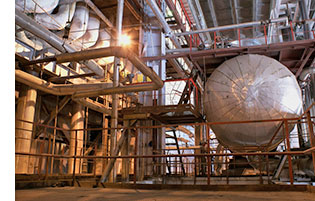 ARBOR says their boards can handle a temperature range of -40 to 185 degrees Fahrenheit (-40C to 85C), and the entire panel PC one of -4 to 140 degrees (-20C to 55C). That should cover even extreme deployments.
ARBOR says their boards can handle a temperature range of -40 to 185 degrees Fahrenheit (-40C to 85C), and the entire panel PC one of -4 to 140 degrees (-20C to 55C). That should cover even extreme deployments.
Panel PCs generally don't have ingress protection ratings for the entire unit. That's because it's assumed that while the front side may be exposed to liquids and dust, the body and backside are inside panel enclosures and thus protected from driving rain, sand or dust. So the ASLAN, like most industrial panels, has a front panel that is sealed to IP65 specs (i.e., totally protected against dust, and also able to handle low pressure jets of water), but the backside does not carry an IP rating.
Industrial panel mounts are generally used in stationary locations, and thus are not subjected to the same levels of shock and vibration as vehicle mounts. However, they must still be able to withstand vibration. ARBOR does provide shock and vibration test results. Do note that those generally assume operation with solid state disks and not the less vibration-resistant rotating media.
The degree of ruggedness required for a certain deployment generally depends on the specific requirements of a job, and it always pays to discuss those in detail with the manufacturer. Equally important is proper mounting, as that can have a major impact on vibration resistance. As far as the equipment itself goes, the ASLAN panel certainly looks and feels up to to the job.
Summary: ARBOR ASLAN W722C
The ASLAN Series of industrial wide-screen panel computers from ARBOR Technology is available in three models with 15.6, 18.5 and 21.5 inch displays. The 21.5-inch W722C version we examined has roughly the footprint of a 21-inch iMac and only weighs a bit more. Designed both for standard industrial deployment and also for emerging Industry 4.0 applications, ASLAN is an interesting mix of conventional and avant-garde industrial panel computer technologies.
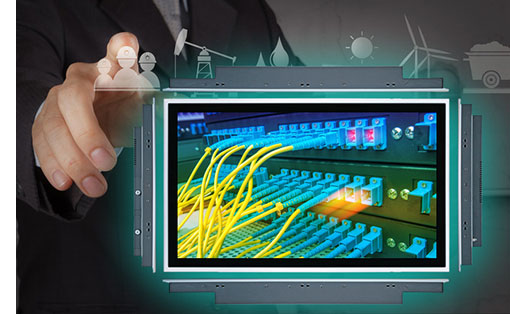 Just to reiterate, "Industry 4.0" refers to a fourth stage of industrial revolution, one where increasingly advanced technology fosters "intelligent" factories that go far beyond just machine control and robotics, and into interacting with numerous internal and external related systems. Just to reiterate, "Industry 4.0" refers to a fourth stage of industrial revolution, one where increasingly advanced technology fosters "intelligent" factories that go far beyond just machine control and robotics, and into interacting with numerous internal and external related systems.
To that extent, the ASLAN panel tends both to the human-machine interface (via an excellent full-HD IPS screen with 10-point capacitive multi-touch) as well as extended machine-to-machine connectivity via three separate LAN interfaces and both USB 3.0 and serial legacy support.
On the processing side, ASLAN is based on an Intel "Bay Trail" Celeron J1900 quad-core chip that offers considerable performance while still easily working in a fanless design. While no other processor is currently offered, the embedded system approach with a separate CPU card makes additional processor and performance options possible.
Even the large 21.5-inch version we reviewed is less than two inches thick, allowing mounting even in space-constrained settings. Storage options are very flexible via two externally accessible 2.5-inch drive bays that can accommodate both rotating and solid state media, including, via adapter, CFast. Construction and manufacturing are exemplary.
Overall, the ARBOR ASLAN is a line of modern wide-screen industrial panel computers suitable for a wide variety of applications, both in conventional settings as well as in emerging smart factory applications. – Conrad H. Blickenstorfer, August 2015
ARBOR Technology ASLAN W722C Specs:
| Added/changed |
Added 08/2015, full review 08/2015
|
| Type |
Industrial Panel PC
|
| Processor |
Quad-core Intel Celeron J1900
|
| clock speed |
2.00GHz (2.42GHz burst speed)
|
| Graphics |
Intel HD Graphics
|
| OS |
Windows 7 Pro, Windows Embedded Standard 7, Windows 8.1 Industry Pro, Ubuntu Linux
|
| Standard/Max RAM |
4GB DDR3L in one SO-DIMM slot |
| Disk/drive |
2 x outside-accessible 2.5" drive bays, optional CFast slot (OEM version); our eval: innodisk Industrial 2.5" SATA SSD 3ME Series
|
| Display type |
TFT LCD, 160 degree vertical, 170 degree horizontal viewing angle, 250 nits, 7H hardness anti-scratch surface |
| Display size/resolution |
21.5-inch/FHD (1920 x 1080 pixel)
|
| Digitizer |
10-point projected capacitive multi-touch |
| Keyboard/keys |
Onscreen
|
| Navigation |
Touch
|
| Expansion slots |
1 x mini card
|
| Housing |
SECC steel chassis, aluminum front bezel
|
| Size |
21.1 x 13.1 x 1.90 inches (536 x 333 x 48 mm)
|
| Weight |
15.4 lb. (7 kg)
|
| Operating temperature |
-4° to 140°F (-20° to 55°C) |
| Ingress protection |
Front panel IP65 (totally dustproof, sealed against low pressure water jets from all directions) |
| Humidity |
10 to 95% non-condensing |
| Shock |
5-Operating 10G 11ms, non-operating 30G 11ms (with CFast/SSD) |
| Vibration |
5-500Hz 0.5Grms random (with CFast/SSD) |
| Altitude |
Unknown |
| ESD |
Unknown |
| Power |
9 to 36 Volt DC |
| Regulatory |
CE/FCC, UL/CB/BSMI |
| Camera |
none |
| Communication |
Optional Atheros AR9462 WiFi module |
| Interface |
1 x USB 3.0, 3 x USB 2.0, 2 x RS232, 2 X RS232/485 with auto-flow control, 3 x RJ45 gigabit LAN, 1 x DVI-I |
| Price |
Inquire |
| Spec sheet |
 ARBOR ASLAN-W722C brochure (PDF) ARBOR ASLAN-W722C brochure (PDF)
|
| Manual |
 ARBOR ASLAN-W722C manual ARBOR ASLAN-W722C manual |
| Web page |
ARBOR ASLAN-W722C web page |
| Contact |
ARBOR Technology Corp.
10F., No.700, Zhongzheng Rd.
Zhonghe Dist., New Taipei City 235
Taiwan, R.O.C.
Tel: 886 2 8226 9396
Fax: 886 2 8226 9398 |
|




